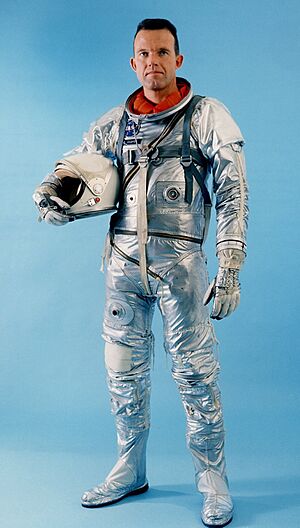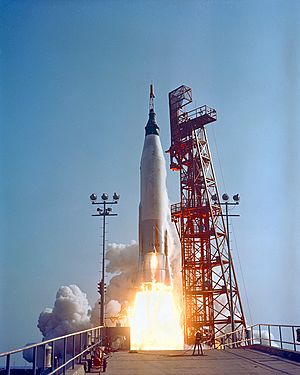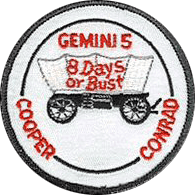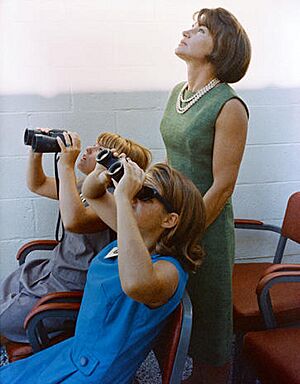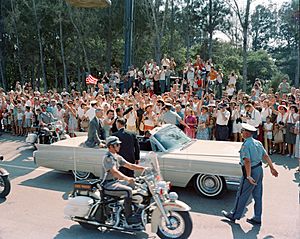Gordon Cooper facts for kids
Quick facts for kids
Gordon Cooper
|
|
|---|---|
 |
|
| Born |
Leroy Gordon Cooper Jr.
March 6, 1927 Shawnee, Oklahoma, U.S.
|
| Died | October 4, 2004 (aged 77) Ventura, California, U.S.
|
| Resting place | Ashes flown into outer space |
| Alma mater |
|
| Occupation | Test pilot |
| Awards |
|
| Space career | |
| NASA astronaut | |
| Rank | Colonel, USAF |
|
Time in space
|
9d 09h 14m |
| Selection | 1959 NASA Group 1 |
| Missions | Mercury-Atlas 9, Gemini 5 |
|
Mission insignia
|
|
| Retirement | July 31, 1970 |
Leroy Gordon "Gordo" Cooper Jr. (March 6, 1927 – October 4, 2004) was an American test pilot and United States Air Force pilot. He was the youngest of the original seven astronauts chosen for Project Mercury. This was the first human space program for the United States.
Cooper learned to fly when he was a child. After serving in the United States Marine Corps during World War II, he joined the United States Air Force in 1949. He became a test pilot in 1956 and was selected as an astronaut in 1959.
In 1963, Cooper flew the longest and last Mercury spaceflight, called Mercury-Atlas 9. During this 34-hour mission, he became the first American to spend a full day in space. He was also the first to sleep in space. He was the last American to fly an orbital mission completely alone. Even with serious equipment problems, he successfully finished the mission by flying the spacecraft manually. He guided his spacecraft, named Faith 7, to land safely near the recovery ship.
Cooper became the first astronaut to fly in space a second time when he commanded Gemini 5 in 1965. With pilot Pete Conrad, he set a new space endurance record. They traveled over 3 million miles in nearly eight days. This showed that astronauts could survive in space long enough for a trip to the Moon and back. After serving as a backup for the Apollo 10 mission, he retired from NASA and the Air Force in 1970.
Contents
Early Life and Learning
Leroy Gordon Cooper Jr. was born on March 6, 1927, in Shawnee, Oklahoma. His mother was a teacher, and his father was a judge and a pilot. His father served in the Navy and Air Force.
Cooper went to Jefferson Elementary School and Shawnee High School. He played football and ran track. He was also a Boy Scout and earned the rank of Life Scout. His parents owned a biplane, and he learned to fly very young. He flew alone for the first time when he was 12. He got his official pilot's license at age 16.
After high school, Cooper joined the United States Marine Corps. He served in the Presidential Honor Guard in Washington, D.C. He was discharged from the Marines in 1946.
Cooper then moved to Hawaii to live with his parents. He started attending the University of Hawaii. There, he met Trudy B. Olson, who also loved flying. They got married in 1947 and had two daughters.
Military Service
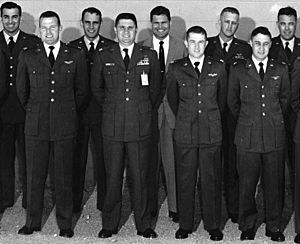
In 1949, Cooper joined the United States Air Force. He completed his flight training in 1950. He then flew F-84 Thunderjets and F-86 Sabres in West Germany for four years.
In 1954, he returned to the United States to study at the Air Force Institute of Technology. He earned a degree in Aerospace Engineering in 1956. While there, he became good friends with Gus Grissom, another future astronaut.
Cooper and Grissom both attended the U.S. Air Force Test Pilot School in California in 1956. After graduating, Cooper became a test pilot at Edwards Air Force Base. He tested different types of fighter jets, including the F-102A and F-106B. By the time he left Edwards, he had flown over 2,000 hours, mostly in jet aircraft.
NASA Career
Project Mercury
In 1959, Cooper was chosen to be one of the first seven American astronauts for Project Mercury. These seven men were known as the Mercury Seven. They were introduced to the public on April 9, 1959.
Each astronaut was given special tasks. Cooper focused on the Redstone rocket, which was used for the first short spaceflights. He also helped create emergency escape plans for the launch pad.
The astronauts were given special Chevrolet Corvette cars to lease for a dollar a year. Cooper, Grissom, and Alan Shepard enjoyed racing their Corvettes around Cape Canaveral. This helped make the Corvette a popular car.
Cooper also worked as a capsule communicator (CAPCOM) for other Mercury missions. He talked to the astronauts from mission control. He was the backup pilot for Wally Schirra's flight in Mercury-Atlas 8.
Mercury-Atlas 9 Mission
Cooper was chosen for the next mission, Mercury-Atlas 9 (MA-9). He was the only one of the original seven astronauts who had not yet flown in space. His mission was planned to last 22 orbits around Earth. Cooper named his spacecraft Faith 7.
On May 15, 1963, Cooper launched into space aboard Faith 7. This was the last mission of Project Mercury. He orbited Earth 22 times, spending 34 hours, 19 minutes, and 49 seconds in space. This was more time than all five previous Mercury astronauts combined. He was the first American astronaut to sleep in orbit.
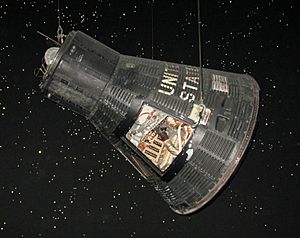
Near the end of the flight, Faith 7 had several serious problems. The power failed, carbon dioxide levels rose, and the cabin got very hot. The clock and gyroscopes also stopped working. However, the radio still worked, allowing Cooper to talk to mission control.
The Mercury flights were designed to be fully automatic. But with his electronics failing, Cooper had to take manual control. He used his knowledge of stars to guide the capsule. He even drew lines on the window to help him aim. He used his wristwatch to time the firing of the re-entry rockets. He landed Faith 7 safely, just 4 miles from the recovery ship, the aircraft carrier USS Kearsarge.
After his successful mission, New York City held a huge parade for Cooper. Over four million people came to celebrate his achievement.
Project Gemini
After Project Mercury, NASA started Project Gemini. These missions carried two astronauts instead of one. Cooper was chosen to command Gemini 5, an eight-day mission. His co-pilot was Pete Conrad.
Cooper and Conrad wanted to name their spacecraft Lady Bird after the First Lady. But NASA wanted to make the space program less about individuals. So, Cooper and Conrad created the idea of a mission patch. This patch would represent everyone involved in the mission. Their patch showed a Conestoga wagon and the words "8 Days or Bust." NASA approved the design but removed the slogan.
Gemini 5 launched on August 21, 1965. The mission faced challenges, including problems with the fuel cell and thrusters. Despite this, Cooper and Conrad were able to complete almost all their planned experiments. They practiced bringing their spacecraft to a specific spot in space. This was important for future missions that would need to meet up with other spacecraft.
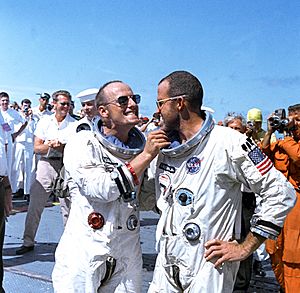
The mission ended early because of a hurricane in the landing area. They splashed down 130 km short of the target due to a computer error. Helicopters picked them up and took them to the recovery ship, the aircraft carrier USS Lake Champlain.
Cooper and Conrad set a new space endurance record. They traveled over 3 million miles in nearly eight days. This proved that astronauts could survive long trips in space, like a journey to the Moon and back. Cooper became the first astronaut to fly in space a second time.
Project Apollo
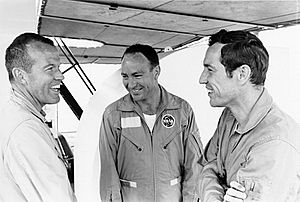
Cooper was chosen as a backup commander for the Apollo 10 mission in May 1969. This usually meant he would be next in line to command a future mission, like Apollo 13. However, when Alan Shepard returned to flight status, he took Cooper's place for that command. This meant Cooper would have to wait much longer for another flight.
Some people at NASA felt Cooper had become too relaxed with his training. Because of this, and the change in crew assignments, Cooper decided to retire. He left NASA and the Air Force on July 31, 1970, as a colonel. He had spent 222 hours in space.
Later Life
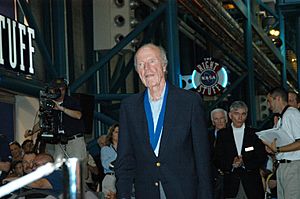
After leaving NASA, Cooper worked for many companies as a technical consultant. He helped with things like boat design, energy, and aircraft design. He was also president of his own consulting firm, Gordon Cooper & Associates, Inc. From 1973 to 1975, he worked for The Walt Disney Company as a vice president for Epcot. In 1989, he became the chief executive of Galaxy Group, Inc., a company that designed small airplanes.
UFO Sightings
In his autobiography, Leap of Faith, Cooper wrote about his experiences with the Air Force and NASA. He also talked about his belief in UFOs.
Cooper claimed he saw his first UFO while flying over West Germany in 1951. He also said that in 1957, at Edwards Air Force Base, a crew saw a "strange-looking, saucer-like" aircraft land. This aircraft made no sound. The crew took pictures, but Cooper was told to send the film to the Pentagon without making copies. He looked at the negatives and said the pictures were excellent. He never found out what happened to those photos.
Cooper claimed until his death that the U.S. government was hiding information about UFOs. He said many other pilots, especially military jet pilots, had reported seeing UFOs. In 1978, he even spoke to the United Nations about the topic. He shared his stories in interviews and in the 2003 documentary Out of the Blue.
Death
Cooper passed away on October 4, 2004, at age 77, from heart failure in California. He was the last American to have flown a solo mission in space until 2004.
Some of Cooper's ashes were launched into space on memorial flights. One flight in 2007 was sub-orbital, meaning it went to space and came back down. The capsule was lost but later found. Another portion of his ashes was launched in 2008 but was lost when the rocket failed. In 2012, more of his ashes were sent into orbit on a SpaceX Dragon capsule.
Awards and Honors
Cooper received many awards, including:
- The Legion of Merit
- The Distinguished Flying Cross
- The NASA Exceptional Service Medal
- The NASA Distinguished Service Medal
- The Collier Trophy
- The Harmon Trophy
He received an honorary science degree from Oklahoma State University in 1967. He was inducted into the Oklahoma Aviation and Space Hall of Fame in 1980. He also joined the International Space Hall of Fame in 1981 and the U.S. Astronaut Hall of Fame in 1990.
Cooper was a member of many organizations, including the Society of Experimental Test Pilots and the Boy Scouts of America. He was also a Freemason.
Cultural Influence
Cooper's life as a Mercury astronaut was shown in the 1983 film The Right Stuff. He was played by actor Dennis Quaid. Cooper worked closely with the filmmakers to make sure his story was told accurately.
He was also portrayed in other TV shows:
- Robert C. Treveiler played him in the 1998 HBO miniseries From the Earth to the Moon.
- Bret Harrison played him in the 2015 ABC TV series The Astronaut Wives Club.
- Colin O'Donoghue played him in the 2020 National Geographic series The Right Stuff.
While in space, Cooper noticed dark spots in the Caribbean waters. He thought these might be the locations of old shipwrecks. The 2017 Discovery Channel show Cooper's Treasure followed someone searching for these shipwrecks using Cooper's old files.
Cooper appeared as himself in an episode of the TV series CHiPs. He also made guest appearances on talk shows in the 1980s. The character Gordon Tracy from the TV series Thunderbirds was named after him.
See also
 In Spanish: Gordon Cooper para niños
In Spanish: Gordon Cooper para niños


